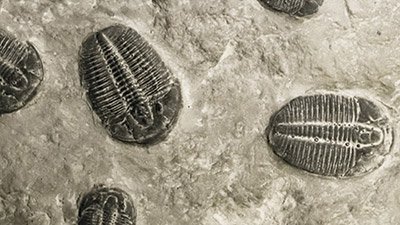
Birds Buried with Dinos at K-T Boundary
Assorted archaic birds buried with dinosaurs up to the K-T boundary.
News Source
Evolutionary paleontologists have long debated how and when archaic birds met their demise. Did they gradually die out during the Cretaceous Period? Or were they catastrophically wiped out by the meteoric mass extinction event that supposedly annihilated “non-avian” dinosaurs?
Analysis of fossilized bird bones from the uppermost Cretaceous layers has for the first time demonstrated a great deal of archaic bird diversity right up to within 300,000 years of the K-T boundary, by evolutionary reckoning. Evolutionists can now be confident that archaic birds went the way of the dinosaurs.
Archaic birds include Archeopteryx and a variety of other toothed birds. Their fossil record had been thought to end in the lower part of the Cretaceous. There is some fossil evidence of modern birds in the Cretaceous layer but a wider variety of them above the K-T (Cretaceous-Tertiary) boundary. Therefore, evolutionists maintain that the K-T boundary represents the time when modern birds evolved.
To resolve the gradual-versus-sudden extinction question, a team from Yale and Saskatchewan examined fossils from the only known locations where the geologic column contains lots of bird fossils in the uppermost part of the Cretaceous. A century’s worth of bird fossils from Hell Creek Formation (in Montana, North Dakota, and South Dakota), Wyoming’s Lance Formation, and Saskatchewan’s Frenchman Formation were sorted and analyzed. The team focused attention on the coracoid bone, a commonly preserved shoulder bone that tends to be fairly distinctive within species, thus eliminating the problem of counting some fossils twice.
The team identified 17 different species of birds. Of these, 7 were archaic birds of various sorts, including several waterfowl. These 7 archaic types have never been found above the K-T boundary. The researchers conclude that a diversity of archaic birds survived right up to the time of the meteoric impact that they believe doomed the dinosaurs and many other types of creatures to extinction.
Radiometric dating of these formations assigns them to the final 1.5 million years of the Cretaceous, and paleomagnetic dating narrows the dates to the final 300,000 years before the apparent mass extinction, by evolutionary reckoning. Molecular clock data has been “conflicting” due, according to the published study, to the lack of a well-dated fossil record.1 Here the research team is acknowledging that molecular clock calculations are wholly dependent on the dating of (and therefore on the assumptions made about) the fossil record.
Yet radiometric dating and paleomagnetic dating is replete with its own set of unverifiable assumptions. In particular, the Hell Creek Formation was re-dated in 2002. The radiometric dates were obtained by argon-argon dating. Argon-argon dating must always be calibrated according to a sample of a known date, but that “known” sample is itself dated by methods that suffer from assumptions about the starting ratios of the radioactive elements present, the constancy of the rate of decay, and the imperviousness of the sample to both contamination and material loss.2
Furthermore, the paleomagnetic dates of this inland continental formation are calibrated by deep sea cores from the South Atlantic. The authors of the re-dating study note that the precision of their results “assumes that sedimentation is constant for the time period being measured, and that all the cycles can be identified and counted.”3 The dates obtained for the strata from which these fossils came are as much a product of circular reasoning as the molecular clock calculations which depend on them.
But what about the archaic birds just below the K-T boundary? Did they get destroyed with the dinosaurs as a result of a meteorite? And why are some modern birds found in the Cretaceous layer? Given that there is no evidence for evolutionary progression from dinosaurs to archaic birds to modern birds, why do they all show up in the Cretaceous layer of western North America?
First of all, we know from the biblical record that we have not found such evolutionary progression because there was none. The Lord created all kinds of animals during Creation week. He created various kinds of birds, whether so-called “archaic” or “modern,” on day five. He created all kinds of dinosaurs on day six. And we have previously discussed the problems with the notion that a meteorite caused mass extinctions. (See “Dinosaur Killer” and “Closing In On the K-T Boundary of Dinosaur Extinction” for a more volcanic explanation of how the global Flood caused the formation of the K-T boundary around 4,300 years ago, not 65 million!)
The layers in the geologic column represent not slow deposition and mass extinctions over millions of years, but rather the order of rapid burial during and soon after the Flood year.
But how do biblical creationists account for the presence of the now-extinct “archaic” birds in the Cretaceous layer and the wide variety of “modern” birds above it? The layers in the geologic column represent not slow deposition and mass extinctions over millions of years, but rather the order of rapid burial during and soon after the Flood year.
The lowest layers are dominated by marine creatures because those would have been the first buried by upheavals as the earth’s crust cracked as described in Genesis 7:11. The distribution of fossils in the higher layers would have depended in part upon animals’ abilities to flee the rising waters.
Birds capable of flight would have been able to flee for quite some time, accounting for their token presence in the Cretaceous and more common presence in layers above it. Many of the “archaic” birds are thought to be waterfowl. It may well be that they, like dinosaurs were native to ecosystems hit sooner by the Flood that those whose creatures are preserved in the higher layers.
Although we can be confident from the biblical record that all these archaic toothed bird kinds were represented on the Ark, they—like the dinosaurs—eventually became extinct some time after the Flood. But they did not become extinct at the K-T boundary. They just got buried in large numbers there. Read more about the biblical interpretation of the geologic column and its fossils in “Doesn’t the Order of Fossils in the Rock Record Favor Long Ages?”
One final note: The researchers definitely made one “biblically accurate” interpretation. Despite the paucity of the Cretaceous bird fossil record in the rest of the world, they feel the fossil record is “consistent with the idea that the catastrophic extinction seen in North America was a global event.”4 Amen.
Further Reading
- Get Answers: Geology
For More Information: Get Answers
Remember, if you see a news story that might merit some attention, let us know about it! (Note: if the story originates from the Associated Press, FOX News, MSNBC, the New York Times, or another major national media outlet, we will most likely have already heard about it.) And thanks to all of our readers who have submitted great news tips to us. If you didn’t catch all the latest News to Know, why not take a look to see what you’ve missed?
(Please note that links will take you directly to the source. Answers in Genesis is not responsible for content on the websites to which we refer. For more information, please see our Privacy Policy.)
Footnotes
- Nicholas R. Longrich et al., “Mass Extinction of Birds at the Cretaceous–Paleogene (K–Pg) Boundary,” PNAS 108, no. 37 (September 13, 2011): 15253–15257, doi:10.1073/pnas.1110395108.
- See “Radiometric Dating: Back to Basics,” “Radiometric Dating: Problems with the Assumptions,” and “Radiometric Dating: Making Sense of the Patterns.”
- Jason F. Hicks et al., “Magnetostratigraphy and Geochronology of the Hell Creek and Basal Fort Union Formations of Southwestern North Dakota and a Recalibration of the Age of the Cretaceous-Tertiary Boundary,” GSA Special Paper 361 (2002): 41, doi:10.1130/0-8137-2361-2.35.
- Longrich et al., “Mass Extinction of Birds at the Cretaceous–Paleogene (K–Pg) Boundary.”
Recommended Resources

Answers in Genesis is an apologetics ministry, dedicated to helping Christians defend their faith and proclaim the good news of Jesus Christ.
- Customer Service 800.778.3390
- Available Monday–Friday | 9 AM–5 PM ET
- © 2026 Answers in Genesis





